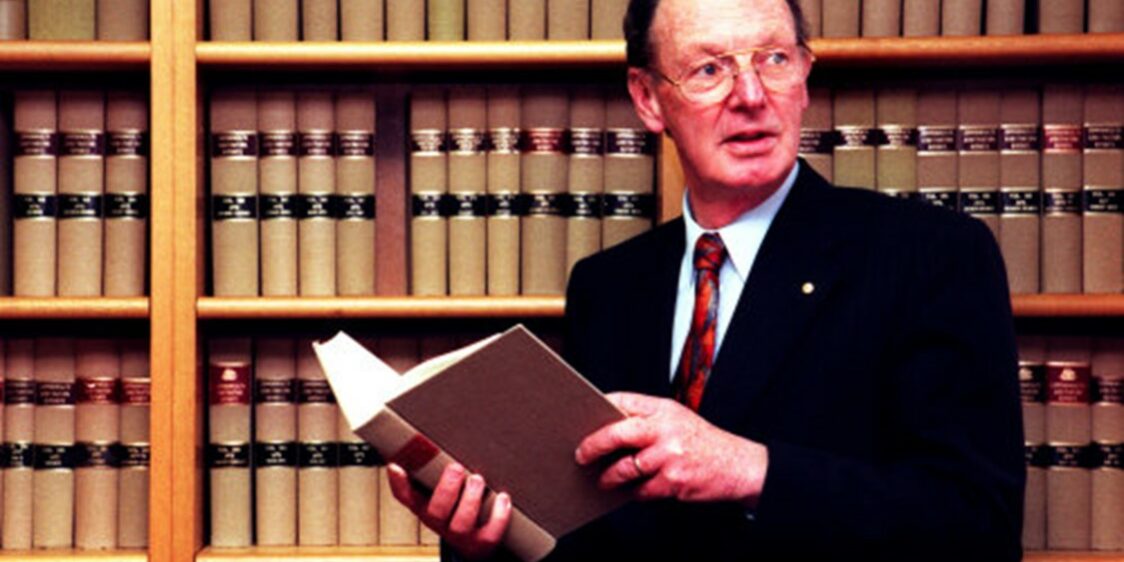Published on-line and slightly edited under the heading ‘Union Man Battled for 38-hour Working Week and Promoted Women’, The Sydney Morning Herald, 9 June 2024
John MacBean was born with the battle for workers’ rights in his blood, secured a 38-hour working week for health workers and promoted women within the union movement.
No union leader from Newcastle ever went as far on the national stage as John William MacBean (1935-2024), Senior Vice President of the Australian Council of Trade Unions, 1985-1989; Secretary, Labor Council of NSW, 1984-1989; President, NSW ALP, 1983-1989; Deputy, then Senior Deputy President, Australian Industrial Relations Commission, 1989-2000.
Born 11 July 1935, in Newcastle, NSW, only child of Jack and Eileen. His father worked as a fitters’ assistant, come first-aid-attendant, at the Broadmeadows Railway Workshops.
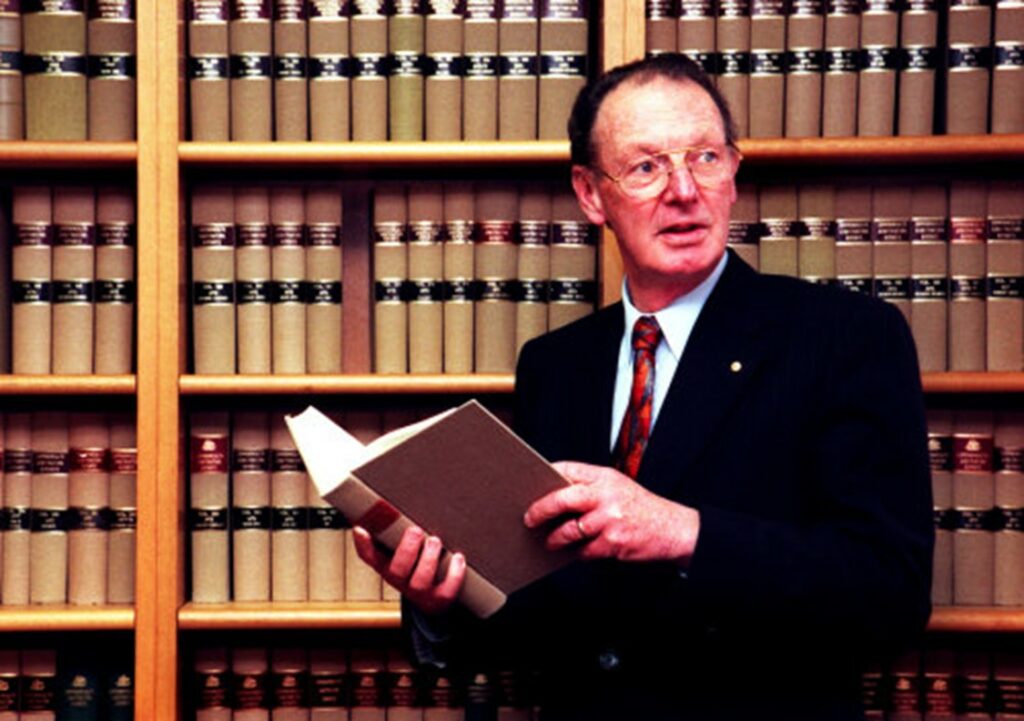
CREDIT: FAIRFAX
The family home, a gun-barrel weatherboard as Novocastrians dubbed the local style, backed onto the railyards. Young MacBean slept to the sound of loco whistles. The elder MacBean held thought-through opinions. He told his son that Marx was more interesting than the communists, and that he shouldn’t be afraid to understand and reckon with opposing views. MacBean Snr. won election as an honorary state vice-president of the Australian Railways Union and was a leading figure in the Adamstown branch of the Labor Party. On many nights, political discussions ranged widely at the dinner table and as meals grew cold, before an exasperated Eileen would call a halt.
The three big industries in the region were the steelworks, the railways, and the steaming coal-fired power stations of Lake Macquarie and the Hunter Valley, the Wangi, Vales Point, Munmorah, Eraring, other power stations, and ancillary operations.
After gaining his Intermediate Certificate from Newcastle Junior Technical School, young MacBean looked for a trade, and was apprenticed as an electrical fitter at the Shortland Electricity Supply Council, where he was employed for 13 years. On his first day of work, he joined the Electrical Trades Union (ETU).
Six years later, barely 21, by now a qualified tradesman, a quiet and unassuming man, lanky, laconic, sporting a ‘mod’ hairstyle, a cut between Elvis and Col Joye, MacBean married his childhood sweetheart, Gail Daly, on 20 July 1956. He won election to the Newcastle City Council, his moderate Labor views in contrast to the dominant Newcastle Labor left.
One day in 1963, walking into the union office in Newcastle, MacBean chatted with a visiting ETU Organiser from Sydney, Barrie Unsworth, a fateful encounter. They talked about unions and politics and continued the discussion over beers at the nearby Delaney’s Hotel. Unsworth, keen to find in the area someone able and reliable, asked MacBean if he would be interested in a union career. Destiny was set. In 1964, MacBean was elected NSW Organiser for the ETU in charge of the Newcastle area.
After winning a competitive three-month ACTU scholarship, in 1969 MacBean attended the Mount Eliza, Victoria, Administrative Staff College where he studied economics, industrial relations, arbitration and management. Another scholarship, a Churchill, enabled MacBean in 1972 to study at the Harvard Business School, completing the 13-week Trade Union Program. That training served him well. Later, MacBean served on the national Pipeline Authority, the Board of Trans Australian Airlines before the Qantas merger, and many other boards.
In 1972 he was appointed Industrial Officer of the Labor Council of NSW (now called Unions NSW), the peak, coordinating body of the unions in the state, where his friend Barrie Unsworth was elected an Organiser in 1967. They rose in tandem. When Unsworth became Assistant Secretary in 1975, MacBean became Organiser, then Assistant Secretary to Unsworth in 1979, then MacBean was elected unopposed as Secretary (head) of the Labor Council in 1984.
MacBean was respected across political divides. In the early 1970s, he led the electricity workers’ successful 35-hour week campaign and the 38-hour week campaigns for health workers and in other industries later that decade.
His style was consensus oriented. For example, the former ACTU President and former teachers’ union official, Jennie George, a lefty – also respected for her shrewd competence, liked him. MacBean promoted women, Patricia Staunton from the Nurses as a Vice President, Beryl Ashe as Organiser, Donna McKenna as Legal Officer, Nola Barber as Manager of radio station 2KY, which the Labor Council owned.
When John Ducker resigned as NSW ALP President in 1979, Paul Keating filled the breach with MacBean serving as Senior Vice President. With the election in March 1983 of the Hawke Labor Government with Keating as Treasurer, MacBean took over as party president. Shyness belied his strengths. Though influential, commanding a wide base of support, seen as honest and straight-forward, MacBean was never entirely comfortable with exercising power.
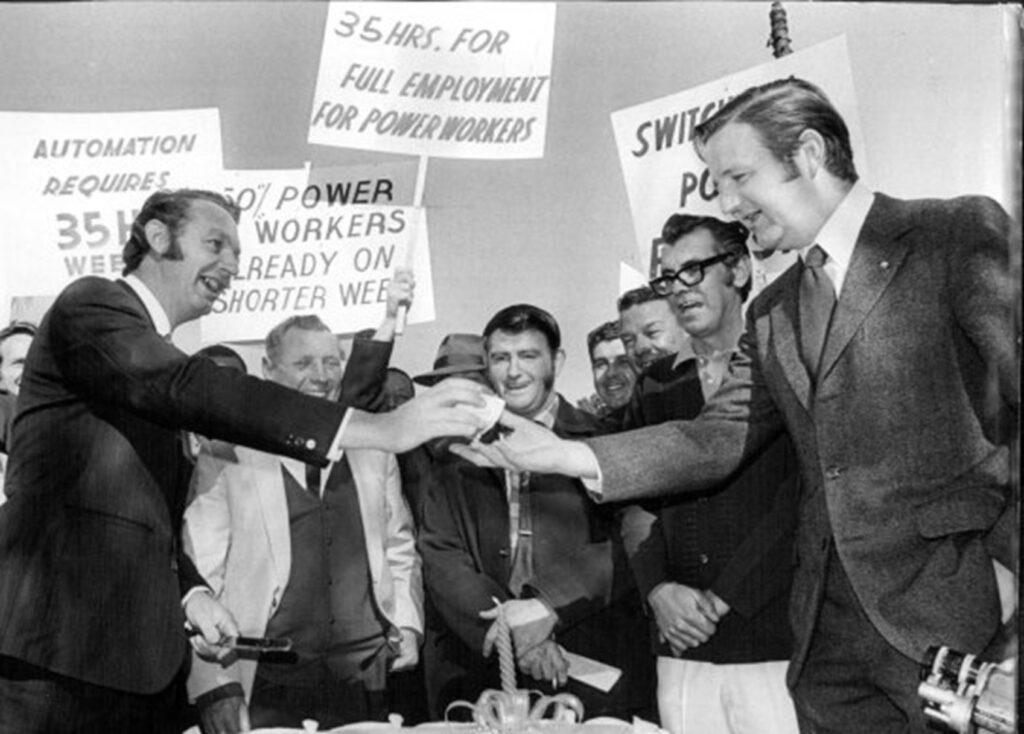
CREDIT: FAIRFAX
In 1985 he called for the deregistration of the militant, lawless Builders’ Laborers’ Federation. His advice was heeded. In September 1985, by 526 votes to 519, MacBean won election as Senior Vice President of the ACTU.
A decisive move brought him national attention. MacBean opposed Robert Holmes à Court’s attempt in 1985/86 to win shareholder control of BHP. He feared asset-stripping and buccaneering, inexperienced management would kill the steel industry.
In March 1986 he said: “We are determined to block Holmes à Court, but it shouldn’t be seen as some long-held philosophical opposition to private enterprise, because we have always accepted it as part and parcel of the Australian economy. …Our only concern is the jobs of steelworkers and their families in three depressed areas of Australia – Whyalla, Port Kembla and Newcastle.”
The second crucial intervention came with the Keating-initiated tax summit in June 1985 and the defeat of ‘Option C’ there. Ross Gittins wrote that Keating faced one large obstacle in the form of MacBean, who feared inequities and inadequate compensation for low-income earners from inflationary impacts of a goods and services tax.
In June 1986, tensions between MacBean and Keating became public. In a newspaper interview MacBean said: “… all great leaders must have some qualities of compassion and humility and I am not sure whether Paul has exhibited enough of those qualities to really demonstrate that he is prime minister material.” The two men who stood on the ramparts in 1979, defending, consolidating, and extending their NSW ALP powerbase were now estranged. At the October 1988 NSW ALP Conference, in introducing the Prime Minister, Bob Hawke, to delegates MacBean said, “The message is clear: they [party members, unions and the community] want you as Prime Minister and Paul Keating as Treasurer — not only for the next election, but beyond.”
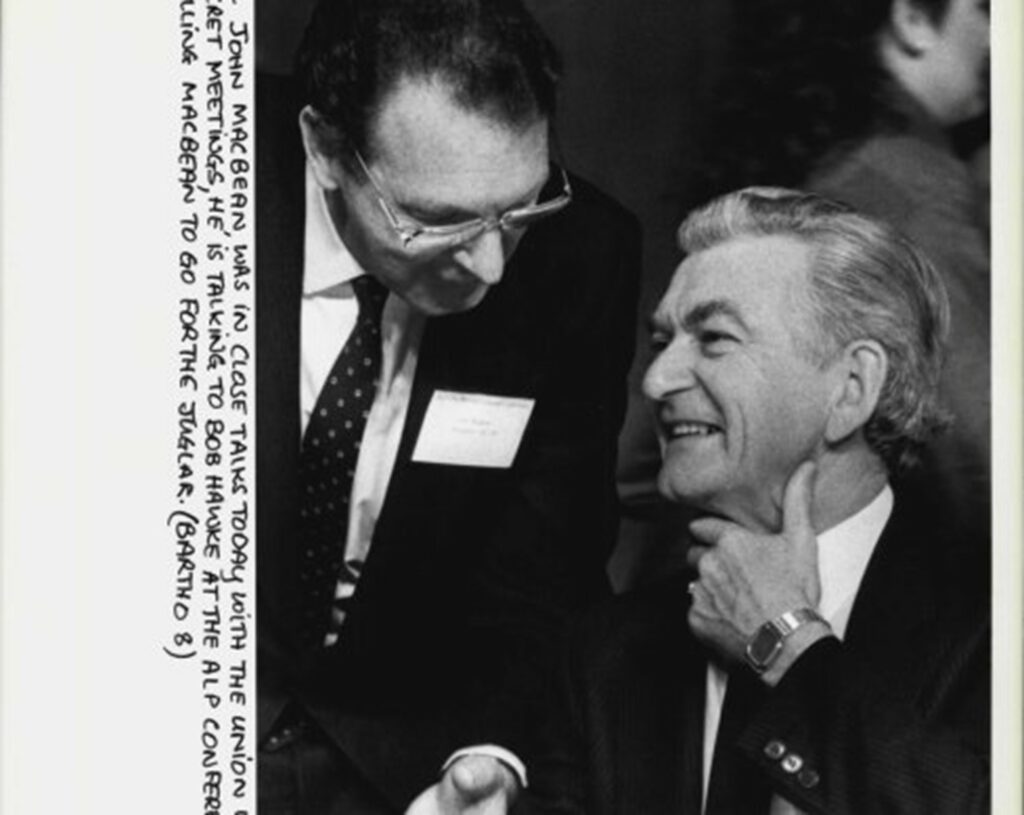
CREDIT: FAIRFAX
In 1986, he participated in the ‘Australia Reconstructed’ trip to West Germany and Sweden where unions and employers compared overseas models and discussed how to improve Australia’s economic performance, out of which the idea of industry union amalgamations was born, notwithstanding MacBean’s reservations.
The Hawke-Keating era was a period of tremendous economic and societal change. Australia opened itself to the world. Along the way, the government provided a helping hand to assist, train, and retrain displaced workers. It was traumatic for many of them and their families. Australia largely avoided the embittered politics of hollowed-out industrial areas, as in the rustbelts of the United States, because union leaders like MacBean insisted on practical measures, subsidies included, to ease the financial burdens. Those measures were important to sustaining union support for the Accords.
MacBean made two decisive interventions in NSW ALP politics. The first occurred in July 1986, when Premier Wran announced at the June NSW ALP Conference his resignation as Premier of NSW. MacBean galvanised support for Barrie Unsworth to succeed Wran as Premier.
Wran was dogged by allegations of corruption and completely exonerated by a Royal Commission into allegations in 1983. But he was damaged when his Prisons Minister, Rex Jackson, resigned and was later convicted for taking bribes to early release prisoners. Never in doubt about Wran’s honesty and integrity, MacBean wanted the clean skin Unsworth as Premier. Unsworth was loved by those who knew him, but he was relatively unknown to the public. He won a by-election in Rockdale by only 54 votes. The legacy of years in government militated against continued success.
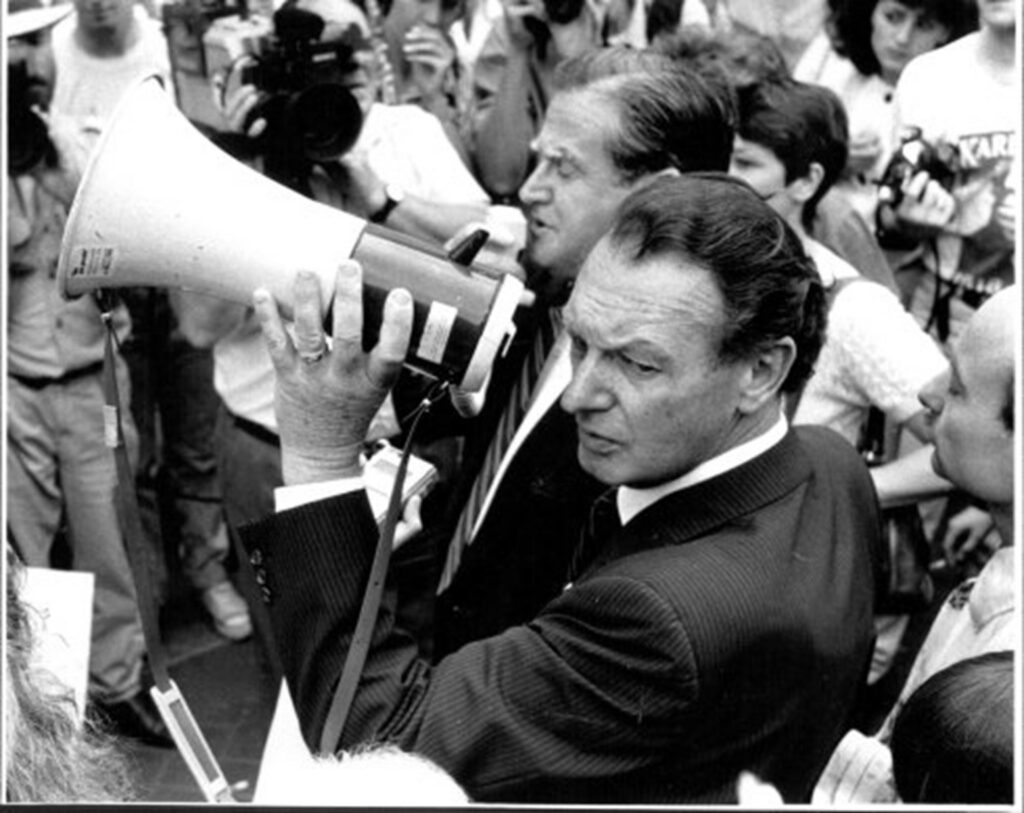
CREDIT: FAIRFAX
In late 1986 and early 1987, workers compensation reforms came to the fore, with the Premier and Labor Council Secretary seeking to keep enough of the movement onside to reduce premiums and concentrate benefits to the catastrophically injured. This battle took its toll.
After the 1988 election loss in NSW, MacBean’s last, great service to his party as NSW ALP President was to advocate for Bob Carr to become Leader of the NSW Opposition.
He served as a member of Pat Hill’s Sydney Cricket Ground Trust but was purged when the Liberals came to power in NSW in 1988. He listed his recreations as bush-walking, opera, and watching old movies. But family mattered most of all. He converted to Catholicism, honouring a pledge that “when they elect a non-Italian Pope, I’m in.” MacBean was awarded the Member of the Order of Australia (AM) in 1986 for services to the union movement and the wider community.
MacBean was in the eye of many political and industrial storms. But he never relished conflict. Exhaustion, a touch of disillusion, together with pride in what he had achieved, characterised his departure from the union movement to the relative obscurity of the industrial tribunals. The breach with Keating particularly hurt.
All his successors in the twenty-seven years following his departure, were individuals he had employed. That was a testament to his skill in perpetuating a legacy of common-sense moderation. MacBean was proud of recruiting from the ETU Iain Ross to serve as Legal Officer of the Labor Council, before the latter headed to the ACTU and a stellar, subsequent career as President of the Fair Work Commission.
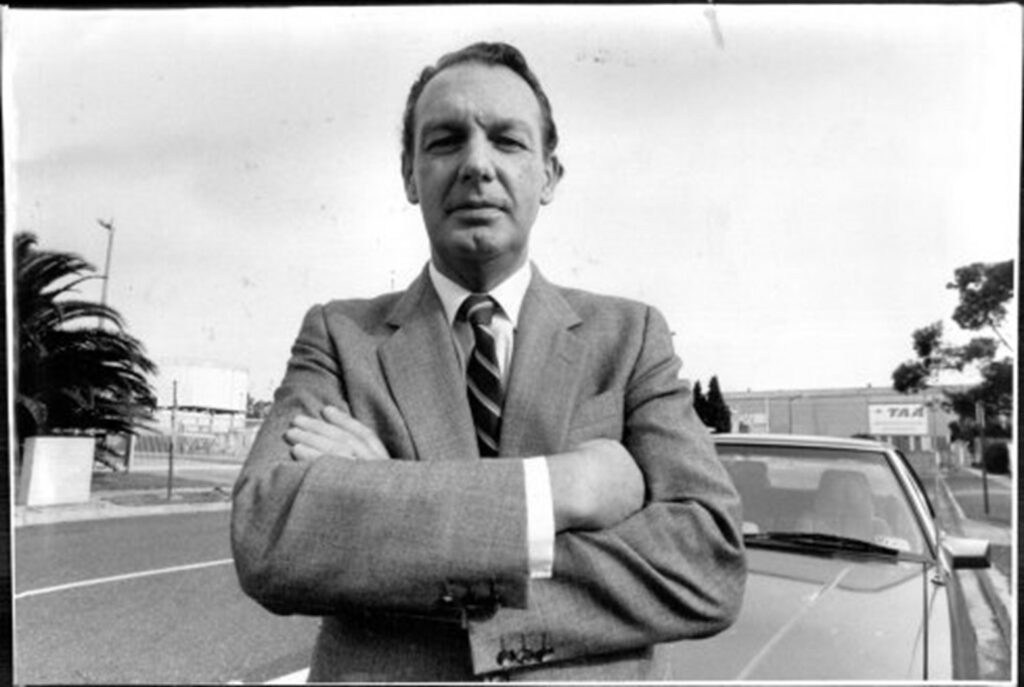
CREDIT: FAIRFAX
Loyal, traditional, conscientious, considerate, polite, never entirely comfortable with the hoi polloi, John MacBean was a humble man. In moving in 1972 from Newcastle to leafy Turramurra, it was to the less salubrious part of that suburb, what he could afford, but still far from the noisy, industrial world he came from. Later, Annandale became homebase, with a four-bedroom, comfortable cottage on a leafy street.
When his son-in-law Glenn died suddenly of a brain aneurysm 20-years ago, his daughter and several grandkids moved in. This was Gail’s and John’s greatest trial and achievement, being everything for their grieving family.
Ailed by Parkinson’s in his last years, he is survived by Gail, with whom he would have celebrated 68 years of marriage this year, his children Darren and Vanessa, daughter in-law Diane, and grandchildren Katie, Frank, Jack, Hugo, Anna, and Daniel.
Michael Easson succeeded John MacBean as Secretary of the Labor Council of NSW in 1989.

